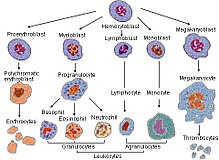Limfoblast
Limfoblast – termin oznaczający zwykle niedojrzałą komórkę, będąca prekursorem limfocytu T lub B, powstającą w trakcie limfopoezy. Są to duże komórki (10-18 μm) o szybkim tempie podziałów komórkowych[1], okrągłym lub owalnym jądrze, zasadochłonną cytoplazmą, której objętość stanowi około 25% objętości jądra [2] oraz z 1-2 jąderkami[3].
W szerszym znaczeniu mianem limfoblastu określa się również komórki białaczkowe wywodzące się z limfocytów lub też duże, szybko proliferujące limfocyty powstające po rozpoznaniu antygenu [4].
Przypisy
- ↑ Harsh Mohan: Essential Pathology for Dental. Jaypee Brothers,Medical Publishers,India, s. 483. ISBN 81-8061-581-2.
- ↑ Jacqueline H. Carr, Bernadette F. Rodak: Clinical Hematology Atlas. Elsevier Health Sciences, 2009, s. 81. ISBN 1-4160-5039-6.
- ↑ Gillian Rozenberg: Microscopic Haematology: A Practical Guide for the Haematology Laboratory. Taylor Francis Group, s. 90. ISBN 90-5702-247-8.
- ↑ CIBA Foundation Symposium: Cellular Aspects of Immunity. Tom 902 z Novartis Foundation Symposia. John Wiley & Sons, 2009, s. 98. ISBN 0-470-71666-5.
Media użyte na tej stronie
This picture is obsolete. the pluripotent stemcell of the blood is giving origin to a lymphoid and a myeloid cell line.

